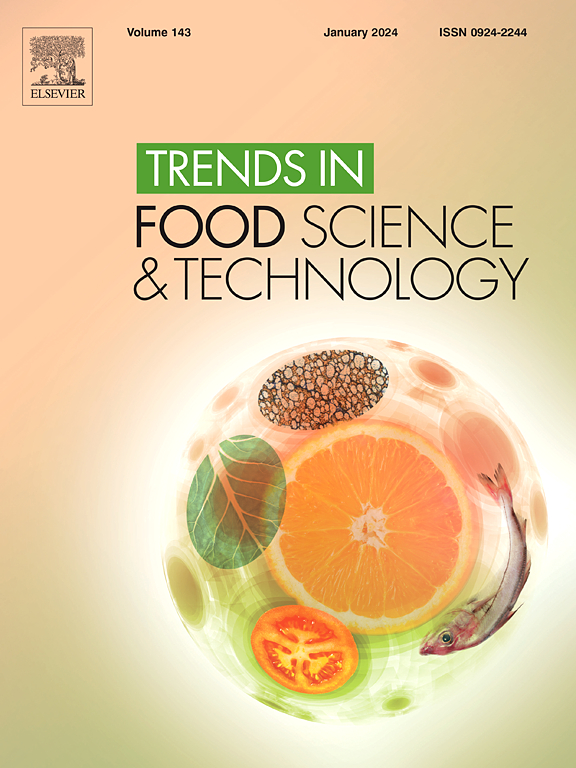苯乳酸的研究进展及发展潜力:来源、抗菌机制及应用
IF 15.1
1区 农林科学
Q1 FOOD SCIENCE & TECHNOLOGY
引用次数: 0
摘要
苯乳酸(PLA)是一种生物安全的抗菌物质,主要由乳酸菌产生,具有广泛的抗菌谱。这种天然衍生的化合物因其在食品安全、医疗、农业加工和其他日常生活领域的应用而受到关注。本文综述了聚乳酸的生物来源、抗菌机制、应用、优势和局限性等方面的研究现状。它进一步探讨了微生物来源的聚乳酸与合成替代品的比较安全性及其抑制细菌,真菌和生物膜形成的机制。此外,提供SWOT分析来评估PLA生产和应用的机会和障碍。聚乳酸显示出多种抑制机制,有效地针对广泛的微生物制剂,包括细菌,真菌和生物膜,突出了其作为食品系统中多功能生物防腐剂的潜力。研究表明,聚乳酸,特别是微生物衍生形式的聚乳酸,通过降低化学添加剂的相关风险和满足消费者对天然产品的需求,比化学合成的对应物具有优势。除了食品保鲜,解放军在农业和医疗保健方面也显示出相当大的前景。然而,SWOT分析显示PLA的生产和应用存在机遇和挑战,特别是在生产可扩展性和监管一致性方面。目前的PLA生产方法在产量和成本效益方面面临限制,而其使用的全球监管标准仍在发展中。标准化的安全性评估和监管框架对于确保PLA作为一种安全有效的生物防腐剂被接受至关重要。本文章由计算机程序翻译,如有差异,请以英文原文为准。

Recent advances and potentiality of phenyllactic acid: Source, antimicrobial mechanism, and applications
Background
Phenyllactic acid (PLA) is a biosafe antimicrobial substance primarily produced by lactic acid bacteria with a broad antimicrobial spectrum. This naturally-derived compound is of interest for its applications in food safety, medical treatments, agricultural processes, and other areas of daily life.
Scope and approach
This review synthesizes current research on PLA, examining its biological sources, antimicrobial mechanisms, applications, and strengths and limitations. It further explores the comparative safety of microbially-derived PLA versus synthetic alternatives and its mechanisms for inhibiting bacteria, fungi, and biofilm formation. Additionally, the SWOT analysis is provided to evaluate the opportunities and obstacles related to PLA production and application.
Key findings and conclusion
PLA demonstrates various inhibitory mechanisms that effectively target a broad spectrum of microbial agents, including bacteria, fungi, and biofilms, highlighting its potential as a multifunctional biopreservative in food systems. Research indicates that PLA, especially in its microbially-derived form, offers advantages over chemically synthesized counterparts by reducing risks associated with chemical additives and aligning with consumer demand for natural products. Beyond food preservation, PLA shows considerable promise in agriculture and healthcare. Nevertheless, the SWOT analyses revealed that the production and application of PLA present opportunities and challenges, particularly concerning production scalability and regulatory consistency. Current methods of PLA production face limitations in yield and cost-effectiveness, while global regulatory standards for its use are still under development. Standardizing safety evaluations and regulatory frameworks will be essential to ensuring the acceptance of PLA as a safe and effective biopreservative.
求助全文
通过发布文献求助,成功后即可免费获取论文全文。
去求助
来源期刊

Trends in Food Science & Technology
工程技术-食品科技
CiteScore
32.50
自引率
2.60%
发文量
322
审稿时长
37 days
期刊介绍:
Trends in Food Science & Technology is a prestigious international journal that specializes in peer-reviewed articles covering the latest advancements in technology, food science, and human nutrition. It serves as a bridge between specialized primary journals and general trade magazines, providing readable and scientifically rigorous reviews and commentaries on current research developments and their potential applications in the food industry.
Unlike traditional journals, Trends in Food Science & Technology does not publish original research papers. Instead, it focuses on critical and comprehensive reviews to offer valuable insights for professionals in the field. By bringing together cutting-edge research and industry applications, this journal plays a vital role in disseminating knowledge and facilitating advancements in the food science and technology sector.
 求助内容:
求助内容: 应助结果提醒方式:
应助结果提醒方式:


